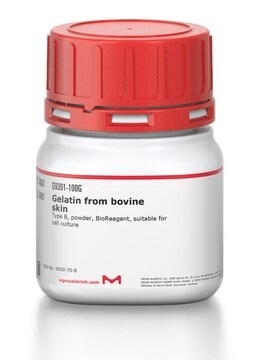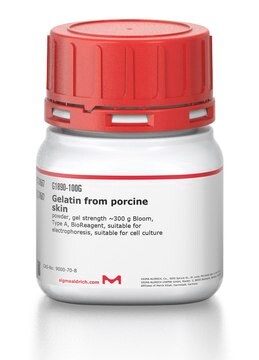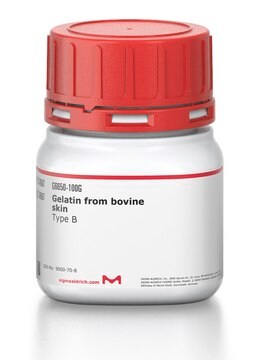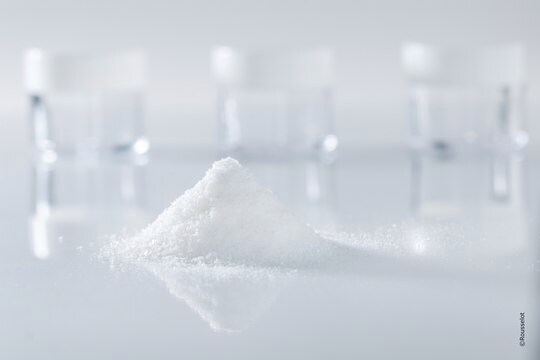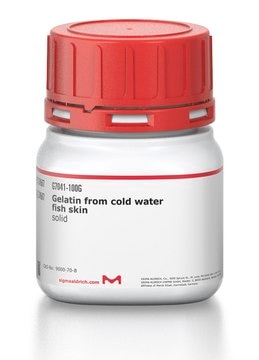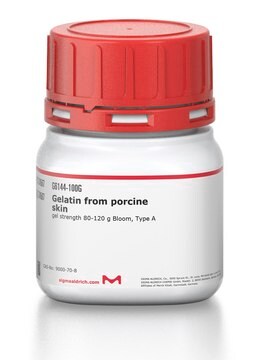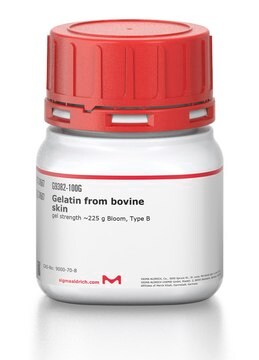918644
Low endotoxin gelatin solution
gel strength (bloom 300)
Synonym(e):
Type A, Bloom 300
Anmeldenzur Ansicht organisationsspezifischer und vertraglich vereinbarter Preise
Alle Fotos(1)
About This Item
UNSPSC-Code:
12352202
NACRES:
NA.23
Empfohlene Produkte
Form
viscous liquid
Qualitätsniveau
Konzentration
20 wt. % in DPBS (buffer)
Verunreinigungen
<25 EU/mL Endotoxin
<5 cfu/mL Bioburden
Farbe
colorless to pale yellow
pH-Wert
6.5-7.5
Lagertemp.
2-8°C
Anwendung
Low endotoxin gelatin solution is a 20% low endotoxin gelatin solution in DPBS buffer. It is sterile filtrated through 0.2 μm sterile filter, and ready to be used in biomedical applications.
Gelatin is widely used for tissue engineering and 3D bioprinting. Gelatin is derived from natural extracellular matrix (ECM) components. Due to its low cost, abundance, and retention of natural cell binding motifs, gelatin has become a highly sought material for tissue engineering applications. Gelatin solution has thermoreversible gelling property which enables synthesis of biocompatible and biodegradable hydrogels and promote cell adhesion, spreading, and proliferation.
Gelatin is widely used for tissue engineering and 3D bioprinting. Gelatin is derived from natural extracellular matrix (ECM) components. Due to its low cost, abundance, and retention of natural cell binding motifs, gelatin has become a highly sought material for tissue engineering applications. Gelatin solution has thermoreversible gelling property which enables synthesis of biocompatible and biodegradable hydrogels and promote cell adhesion, spreading, and proliferation.
Verpackung
10 mL in glass bottle
Lagerklassenschlüssel
10 - Combustible liquids
WGK
WGK 3
Hier finden Sie alle aktuellen Versionen:
Analysenzertifikate (COA)
Lot/Batch Number
Leider sind derzeit keine COAs für dieses Produkt online verfügbar.
Wenn Sie Hilfe benötigen, wenden Sie sich bitte an Kundensupport
Besitzen Sie dieses Produkt bereits?
In der Dokumentenbibliothek finden Sie die Dokumentation zu den Produkten, die Sie kürzlich erworben haben.
J M Harlan et al.
Laboratory investigation; a journal of technical methods and pathology, 48(3), 269-274 (1983-03-01)
Lipopolysaccharide (LPS) produced time- and dose-dependent bovine endothelial cell injury in vitro that was manifested initially by cell detachment from culture substrate with subsequent cell lysis. Bovine endothelial cell injury was observed with LPS derived from Salmonella minnesota R595, a
Unser Team von Wissenschaftlern verfügt über Erfahrung in allen Forschungsbereichen einschließlich Life Science, Materialwissenschaften, chemischer Synthese, Chromatographie, Analytik und vielen mehr..
Setzen Sie sich mit dem technischen Dienst in Verbindung.
